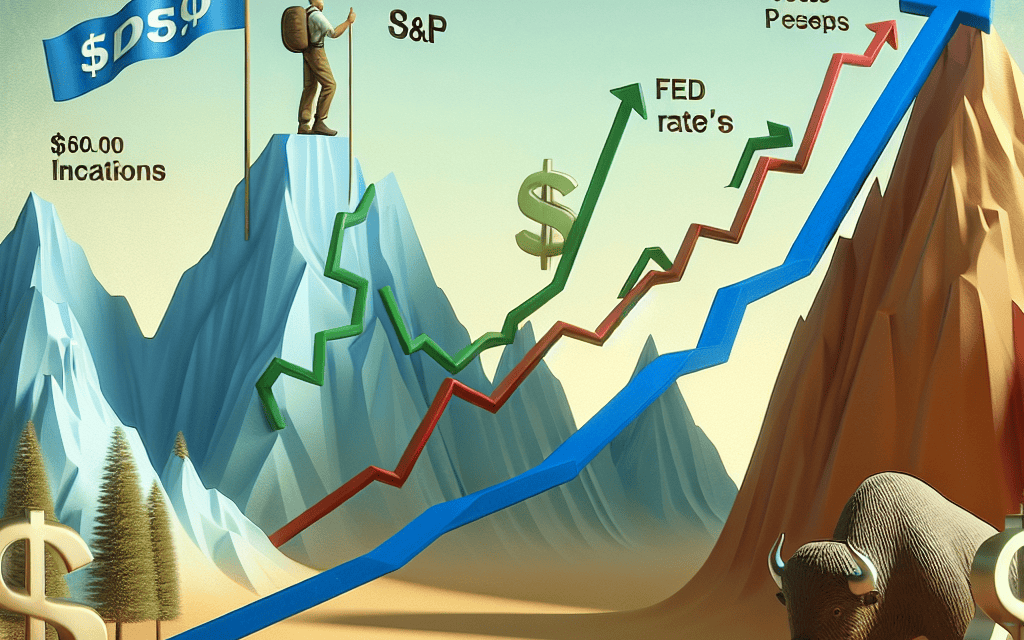“Market Momentum: Dow and S&P Surge, Nasdaq Lags as Inflation and Fed Rate Cut Loom Large”
Introduction
In the ever-evolving landscape of global finance, the stock market remains a barometer of economic sentiment and investor confidence. Recently, the Dow Jones Industrial Average and the S&P 500 have shown upward momentum, reflecting a cautiously optimistic outlook among investors. This rise comes amid ongoing discussions about inflationary pressures and the potential for future interest rate cuts by the Federal Reserve. In contrast, the Nasdaq Composite has lagged behind, highlighting sector-specific challenges and the varied impact of economic indicators on different market segments. As investors navigate these complex dynamics, the interplay between inflation data and monetary policy continues to shape market trajectories and investment strategies.
Dow Jones and S&P 500 Surge: Key Drivers Behind the Climb
In recent trading sessions, the Dow Jones Industrial Average and the S&P 500 have experienced notable gains, while the Nasdaq Composite has lagged behind. This divergence in performance among the major indices can be attributed to a confluence of factors, including inflationary pressures and the evolving expectations surrounding Federal Reserve interest rate policies. As investors navigate these complex dynamics, understanding the key drivers behind the Dow and S&P 500’s ascent becomes crucial.
To begin with, the Dow Jones and S&P 500 have been buoyed by robust corporate earnings reports, which have exceeded analysts’ expectations in several sectors. Companies in the industrial and consumer discretionary sectors, in particular, have demonstrated resilience, showcasing strong revenue growth and effective cost management strategies. This positive earnings momentum has instilled confidence among investors, prompting a rotation into value stocks that are well-represented in the Dow and S&P 500 indices. Consequently, these indices have outperformed the tech-heavy Nasdaq, which has been more susceptible to volatility amid shifting market sentiments.
Moreover, the prospect of a potential Federal Reserve interest rate cut has further fueled optimism in the stock market. Recent economic data indicating a moderation in inflationary pressures has led to increased speculation that the Fed may adopt a more accommodative monetary policy stance. This anticipation of lower borrowing costs has provided a tailwind for equities, particularly those in sectors that are sensitive to interest rate changes, such as financials and real estate. As a result, the Dow and S&P 500 have benefited from this favorable macroeconomic backdrop, attracting investors seeking to capitalize on the potential for sustained economic growth.
In addition to these factors, geopolitical developments have also played a role in shaping market dynamics. The easing of trade tensions between major economies has alleviated some of the uncertainties that have weighed on global markets in recent months. The resolution of key trade disputes has bolstered investor sentiment, encouraging a more risk-on approach and driving capital flows into equities. This renewed confidence has been particularly advantageous for the Dow and S&P 500, which include multinational corporations with significant international exposure.
However, it is important to acknowledge that the Nasdaq’s relative underperformance is not solely a reflection of negative sentiment towards technology stocks. Rather, it underscores the market’s recalibration as investors reassess valuations in the context of rising interest rates and potential regulatory challenges. While the tech sector remains a cornerstone of innovation and growth, its high valuations have made it more vulnerable to shifts in market dynamics. Consequently, investors have exhibited a more cautious approach towards tech stocks, opting instead for sectors that offer more immediate value and stability.
In conclusion, the recent surge in the Dow Jones and S&P 500 can be attributed to a combination of strong corporate earnings, favorable monetary policy expectations, and improved geopolitical conditions. These factors have collectively contributed to a positive market environment, fostering investor confidence and driving gains in these indices. As the economic landscape continues to evolve, market participants will remain vigilant, closely monitoring developments in inflation and Federal Reserve policy to gauge their potential impact on future market performance.
Nasdaq’s Underperformance: Analyzing the Factors
In recent weeks, the stock market has exhibited a mixed performance, with the Dow Jones Industrial Average and the S&P 500 showing notable gains, while the Nasdaq Composite has lagged behind. This divergence in performance can be attributed to a confluence of factors, primarily revolving around inflation concerns and the Federal Reserve’s potential rate cut decisions. As investors navigate these complex dynamics, it is essential to understand the underlying reasons for the Nasdaq’s underperformance compared to its counterparts.
To begin with, the Nasdaq Composite is heavily weighted towards technology and growth-oriented stocks, which are particularly sensitive to interest rate fluctuations. In an environment where inflationary pressures are mounting, the Federal Reserve faces the challenging task of balancing economic growth with price stability. The anticipation of potential rate cuts, aimed at curbing inflation, has created a sense of uncertainty among investors. This uncertainty disproportionately affects technology stocks, as higher interest rates can increase borrowing costs and reduce the present value of future earnings, making these stocks less attractive.
Moreover, the technology sector has been grappling with its own set of challenges, further contributing to the Nasdaq’s underperformance. Supply chain disruptions, which have persisted since the onset of the COVID-19 pandemic, continue to impact the production and delivery of key components essential for tech companies. These disruptions have led to increased costs and delays, affecting profit margins and investor sentiment. Additionally, regulatory scrutiny on major tech firms, particularly in areas such as data privacy and antitrust concerns, has added another layer of complexity, causing investors to reassess the growth prospects of these companies.
In contrast, the Dow Jones Industrial Average and the S&P 500 have benefited from a more diversified composition, with significant exposure to sectors that are less sensitive to interest rate changes. For instance, financial stocks, which constitute a substantial portion of these indices, tend to perform well in rising interest rate environments, as higher rates can lead to improved profit margins for banks and other financial institutions. Furthermore, sectors such as energy and materials have experienced a resurgence, driven by increased demand and higher commodity prices, providing a boost to these indices.
Another factor contributing to the Nasdaq’s relative underperformance is the rotation of investor preferences. As inflation concerns persist, there has been a noticeable shift from growth stocks to value stocks, which are perceived as more stable and less susceptible to interest rate volatility. This rotation has favored sectors such as industrials, consumer staples, and utilities, which are more prominently represented in the Dow and S&P 500, thereby supporting their upward trajectory.
In conclusion, the Nasdaq’s underperformance in the current market environment can be attributed to a combination of factors, including sensitivity to interest rate changes, sector-specific challenges, and a shift in investor preferences. As the Federal Reserve continues to navigate the delicate balance between fostering economic growth and controlling inflation, the stock market is likely to remain volatile. Investors will need to stay vigilant, closely monitoring economic indicators and policy decisions, to make informed investment choices. While the Nasdaq may face headwinds in the short term, its long-term growth potential remains intact, particularly as technological innovation continues to drive economic transformation.
Inflation Concerns: Impact on Stock Market Trends
In recent weeks, the stock market has been a focal point of intense scrutiny as investors navigate the complex landscape shaped by inflation concerns and the potential for Federal Reserve rate cuts. The Dow Jones Industrial Average and the S&P 500 have shown resilience, climbing steadily despite the economic uncertainties. In contrast, the Nasdaq Composite has lagged, reflecting the varied impacts of inflation on different sectors. This divergence underscores the nuanced ways in which inflationary pressures are influencing market trends.
Inflation, a persistent concern for both policymakers and investors, has been driven by a combination of supply chain disruptions, labor shortages, and rising commodity prices. These factors have contributed to an environment where the cost of goods and services continues to rise, eroding purchasing power and prompting fears of an overheated economy. As a result, investors are closely monitoring the Federal Reserve’s response, particularly the possibility of interest rate cuts aimed at tempering inflationary pressures.
The prospect of rate cuts has injected a degree of optimism into the markets, particularly for the Dow and the S&P 500. These indices, which are more heavily weighted towards industrials and consumer staples, have benefited from the perception that lower interest rates could stimulate economic activity and bolster corporate earnings. Companies in these sectors are often seen as more resilient to inflation, as they can pass on higher costs to consumers without significantly impacting demand. Consequently, the Dow and the S&P 500 have experienced upward momentum, reflecting investor confidence in their ability to weather the inflationary storm.
Conversely, the Nasdaq Composite, which is heavily weighted towards technology and growth stocks, has faced headwinds. These sectors are more sensitive to interest rate changes, as their valuations are often based on future earnings potential. Higher inflation can lead to increased borrowing costs, which in turn can dampen the growth prospects of tech companies that rely on cheap capital to fund innovation and expansion. As a result, the Nasdaq has trailed its counterparts, highlighting the challenges faced by growth-oriented sectors in an inflationary environment.
Despite these challenges, there are signs that the market is beginning to adapt to the new economic realities. Investors are increasingly seeking out companies with strong balance sheets and pricing power, which are better positioned to navigate inflationary pressures. Additionally, there is growing interest in sectors such as energy and materials, which stand to benefit from rising commodity prices. This shift in investment strategies reflects a broader recognition that inflation, while a significant concern, also presents opportunities for those willing to adjust their portfolios accordingly.
In conclusion, the current stock market trends underscore the complex interplay between inflation concerns and the potential for Federal Reserve rate cuts. While the Dow and the S&P 500 have shown resilience, the Nasdaq’s struggles highlight the challenges faced by growth sectors in an inflationary environment. As investors continue to navigate these uncertainties, the focus will remain on identifying opportunities that align with the evolving economic landscape. By staying attuned to these dynamics, investors can better position themselves to capitalize on the opportunities that arise in this challenging yet potentially rewarding environment.
Federal Reserve Rate Cut Prospects: Market Reactions

In recent weeks, the stock market has been a focal point of investor attention, particularly as the Dow Jones Industrial Average and the S&P 500 have shown signs of resilience, while the Nasdaq Composite has lagged behind. This divergence in performance can be attributed to a variety of factors, with inflationary pressures and the Federal Reserve’s potential rate cut playing pivotal roles in shaping market sentiment. As investors navigate these complex dynamics, understanding the interplay between inflation, interest rates, and market performance becomes crucial.
To begin with, inflation has been a persistent concern for both policymakers and investors. Rising prices have the potential to erode purchasing power and squeeze profit margins, leading to heightened uncertainty in the markets. However, recent data suggests that inflationary pressures may be easing, albeit gradually. This has provided a glimmer of hope for investors, as a slowdown in inflation could alleviate some of the pressure on the Federal Reserve to maintain its aggressive monetary tightening stance. Consequently, the prospect of a rate cut by the Federal Reserve has gained traction, offering a potential catalyst for market optimism.
The anticipation of a rate cut has had a notable impact on the Dow and the S&P 500, both of which have experienced upward momentum. Investors are increasingly optimistic that a reduction in interest rates could stimulate economic activity by lowering borrowing costs for businesses and consumers alike. This optimism is reflected in the performance of sectors that are particularly sensitive to interest rates, such as financials and consumer discretionary stocks. As these sectors gain traction, they contribute to the overall strength of the Dow and the S&P 500, underscoring the market’s positive response to the possibility of a more accommodative monetary policy.
In contrast, the Nasdaq Composite has not shared in the same level of enthusiasm. The technology-heavy index has faced headwinds, partly due to its exposure to high-growth tech stocks that are more vulnerable to interest rate fluctuations. Higher rates can increase the cost of capital for these companies, potentially dampening their growth prospects. Additionally, the recent rotation from growth to value stocks has further weighed on the Nasdaq, as investors seek to capitalize on sectors that may benefit more directly from an economic recovery. Despite these challenges, it is important to note that the Nasdaq’s underperformance does not necessarily indicate a lack of confidence in the tech sector’s long-term potential, but rather reflects the current market dynamics and investor preferences.
As the Federal Reserve continues to assess economic conditions, its decisions regarding interest rates will remain a key driver of market movements. While the prospect of a rate cut has buoyed certain segments of the market, it is essential for investors to remain vigilant and consider the broader economic landscape. Factors such as geopolitical tensions, supply chain disruptions, and labor market dynamics could all influence the Fed’s policy decisions and, by extension, market performance.
In conclusion, the stock market’s recent behavior highlights the intricate relationship between inflation, interest rates, and investor sentiment. As the Dow and S&P 500 climb on hopes of a Federal Reserve rate cut, the Nasdaq’s relative underperformance serves as a reminder of the diverse factors at play. Moving forward, market participants will closely monitor economic indicators and Fed communications, seeking to navigate the evolving landscape with informed strategies and a keen awareness of potential risks and opportunities.
Sector Analysis: Winners and Losers in the Current Market
In the current market landscape, the stock market has been characterized by a mixed performance across various sectors, with the Dow Jones Industrial Average and the S&P 500 showing gains, while the Nasdaq Composite lags behind. This divergence in performance can be attributed to a confluence of factors, including inflationary pressures and the potential for future interest rate cuts by the Federal Reserve. As investors navigate these complex dynamics, it is crucial to examine the sectors that are emerging as winners and those that are facing challenges.
To begin with, the energy sector has been a standout performer, driven by rising oil prices and increased demand for energy resources. Companies within this sector have benefited from geopolitical tensions and supply chain disruptions, which have contributed to higher commodity prices. As a result, energy stocks have seen significant appreciation, providing a boost to indices like the Dow and the S&P 500. Furthermore, the sector’s strong cash flows and attractive dividend yields have made it an appealing choice for investors seeking stability amid market volatility.
In contrast, the technology sector, which is heavily represented in the Nasdaq Composite, has faced headwinds. Concerns over inflation have led to increased scrutiny of high-growth tech stocks, as rising costs could potentially erode profit margins. Additionally, the prospect of interest rate cuts by the Federal Reserve has created uncertainty around the valuation of these companies, which are often valued based on future earnings potential. Consequently, tech stocks have experienced a pullback, contributing to the Nasdaq’s underperformance relative to its peers.
Meanwhile, the financial sector has shown resilience, buoyed by the anticipation of interest rate cuts. Lower interest rates can enhance the profitability of banks and financial institutions by reducing borrowing costs and stimulating economic activity. This environment has fostered optimism among investors, leading to a rally in financial stocks. Moreover, the sector’s strong capital positions and prudent risk management practices have further bolstered investor confidence.
On the other hand, the consumer discretionary sector has encountered challenges, as inflationary pressures have weighed on consumer spending. Rising prices for goods and services have strained household budgets, leading to a shift in spending patterns. Companies within this sector are grappling with the dual challenge of managing higher input costs while maintaining competitive pricing strategies. As a result, consumer discretionary stocks have faced headwinds, reflecting the broader economic uncertainties.
In addition, the healthcare sector has demonstrated mixed performance, with some segments thriving while others face obstacles. Pharmaceutical companies have benefited from robust demand for innovative treatments and vaccines, driving growth in this sub-sector. However, healthcare providers and insurers are contending with regulatory changes and cost pressures, which have tempered their performance. This divergence within the sector underscores the importance of a nuanced approach to investing in healthcare stocks.
In summary, the current market environment presents a complex tapestry of opportunities and challenges across different sectors. While the energy and financial sectors have emerged as winners, buoyed by favorable macroeconomic conditions, the technology and consumer discretionary sectors face hurdles amid inflationary pressures and interest rate uncertainties. As investors assess these dynamics, a careful evaluation of sector-specific factors and broader economic trends will be essential in navigating the evolving market landscape.
Investor Sentiment: How Inflation and Rate Cuts Influence Decisions
Investor sentiment plays a crucial role in shaping the dynamics of the stock market, and recent developments have highlighted the intricate relationship between inflation, Federal Reserve rate cut prospects, and market performance. As the Dow Jones Industrial Average and the S&P 500 index experience upward momentum, the Nasdaq Composite lags behind, reflecting the nuanced responses of investors to economic indicators and monetary policy expectations.
To begin with, inflation remains a pivotal factor influencing investor decisions. Rising prices have been a persistent concern, as they erode purchasing power and create uncertainty about future economic conditions. In response to inflationary pressures, the Federal Reserve has been closely monitoring economic data to determine the appropriate course of action. The prospect of rate cuts has emerged as a potential tool to mitigate the impact of inflation, providing a sense of relief to investors who are wary of prolonged price increases. Consequently, the anticipation of rate cuts has contributed to the positive performance of the Dow and S&P 500, as investors perceive these indices as more resilient to economic fluctuations.
Moreover, the divergence in performance between the Dow, S&P 500, and Nasdaq can be attributed to the varying sector compositions of these indices. The Dow and S&P 500 are more heavily weighted towards sectors such as industrials, financials, and consumer staples, which tend to benefit from a stable economic environment and are less sensitive to interest rate changes. On the other hand, the Nasdaq is dominated by technology stocks, which are more susceptible to interest rate fluctuations due to their reliance on future earnings growth. As a result, the Nasdaq has been more vulnerable to investor apprehensions regarding inflation and potential rate cuts, leading to its relatively subdued performance.
In addition to sectoral differences, investor sentiment is also shaped by broader economic indicators and geopolitical developments. For instance, recent data releases on employment and consumer spending have provided mixed signals about the health of the economy, prompting investors to reassess their strategies. While strong job growth and robust consumer spending suggest economic resilience, concerns about supply chain disruptions and global trade tensions continue to weigh on market sentiment. These factors contribute to the cautious optimism observed in the Dow and S&P 500, as investors balance the potential benefits of rate cuts against the risks posed by external uncertainties.
Furthermore, the Federal Reserve’s communication strategy plays a significant role in shaping investor expectations. Clear and consistent messaging from the Fed can help anchor market sentiment, reducing volatility and fostering confidence among investors. As the central bank navigates the complex landscape of inflation and rate cuts, its ability to convey a coherent policy outlook will be critical in influencing investor decisions. In this context, the recent statements from Fed officials indicating a willingness to consider rate cuts have been instrumental in bolstering investor confidence, particularly in sectors less exposed to interest rate risks.
In conclusion, the interplay between inflation, Federal Reserve rate cut prospects, and investor sentiment is a key driver of stock market performance. As the Dow and S&P 500 climb while the Nasdaq trails, it is evident that investors are carefully weighing the implications of economic indicators and monetary policy on their investment strategies. By understanding these dynamics, investors can better navigate the complexities of the market and make informed decisions that align with their financial goals.
Future Outlook: Predictions for Dow, S&P 500, and Nasdaq
As the financial markets continue to navigate a complex landscape of economic indicators and policy decisions, investors are keenly focused on the future trajectory of major indices such as the Dow Jones Industrial Average, the S&P 500, and the Nasdaq Composite. Recent movements in these indices have been influenced by a confluence of factors, including inflationary pressures and the Federal Reserve’s monetary policy stance. While the Dow and S&P 500 have shown resilience with upward momentum, the Nasdaq has lagged, reflecting sector-specific challenges and broader market dynamics.
Looking ahead, the future outlook for these indices is shaped by several key considerations. Firstly, inflation remains a pivotal factor. Persistent inflationary pressures have prompted the Federal Reserve to adopt a more cautious approach, balancing the need to curb inflation with the desire to support economic growth. The prospect of future rate cuts by the Fed is a double-edged sword for the stock market. On one hand, lower interest rates can stimulate economic activity and boost corporate earnings, which is generally positive for stock prices. On the other hand, the underlying reasons for rate cuts, such as economic slowdown or persistent inflation, could pose risks to market stability.
For the Dow Jones Industrial Average, which comprises 30 large-cap companies, the outlook is relatively optimistic. The index is likely to benefit from its exposure to sectors that are less sensitive to interest rate fluctuations, such as consumer staples and healthcare. These sectors tend to perform well in uncertain economic environments, providing a buffer against potential market volatility. Moreover, the Dow’s focus on established companies with strong balance sheets positions it favorably in an environment where investors may seek safety and stability.
In contrast, the S&P 500, which represents a broader cross-section of the U.S. economy, faces a more nuanced outlook. While the index has shown strength, driven by robust earnings reports from key constituents, it remains susceptible to sector-specific headwinds. Technology and growth-oriented sectors, which have been significant drivers of the S&P 500’s performance in recent years, may face challenges if interest rates remain elevated or if economic growth slows. However, the index’s diversification across various sectors provides a degree of resilience, allowing it to weather potential downturns in specific areas.
The Nasdaq Composite, heavily weighted towards technology and growth stocks, presents a more complex picture. The index has trailed its peers, reflecting investor concerns about the impact of rising interest rates on high-growth companies. These companies often rely on borrowing to finance expansion, making them more vulnerable to higher interest costs. Additionally, the tech sector faces regulatory scrutiny and geopolitical tensions, which could further weigh on investor sentiment. Nevertheless, the long-term growth prospects for technology remain robust, driven by innovation and digital transformation across industries. As such, the Nasdaq may experience volatility in the short term but holds potential for recovery as macroeconomic conditions stabilize.
In conclusion, the future outlook for the Dow, S&P 500, and Nasdaq is shaped by a complex interplay of economic indicators, monetary policy decisions, and sector-specific dynamics. While each index faces unique challenges and opportunities, investors should remain vigilant and adaptable, considering both short-term market fluctuations and long-term growth prospects. As the economic landscape continues to evolve, these indices will likely reflect the broader trends and shifts in the global economy, offering insights into the future direction of financial markets.
Q&A
1. **Question:** What recent trend has been observed in the Dow Jones Industrial Average?
– **Answer:** The Dow Jones Industrial Average has recently climbed.
2. **Question:** How has the S&P 500 performed in the latest stock market update?
– **Answer:** The S&P 500 has also shown an upward trend, climbing alongside the Dow.
3. **Question:** What is the current performance of the Nasdaq in comparison to the Dow and S&P 500?
– **Answer:** The Nasdaq is trailing behind the Dow and S&P 500 in terms of performance.
4. **Question:** What economic factor is influencing the current stock market trends?
– **Answer:** Inflation is a significant factor influencing the current stock market trends.
5. **Question:** How are prospects of a Federal Reserve rate cut affecting the stock market?
– **Answer:** Prospects of a Federal Reserve rate cut are contributing to the positive performance of the Dow and S&P 500.
6. **Question:** Why might the Nasdaq be underperforming compared to the other indices?
– **Answer:** The Nasdaq might be underperforming due to its higher concentration of technology stocks, which can be more sensitive to interest rate changes and inflation concerns.
7. **Question:** What is the general market sentiment regarding future Federal Reserve actions?
– **Answer:** The market sentiment is cautiously optimistic about potential future Federal Reserve rate cuts, which could further influence stock market performance.
Conclusion
The recent stock market update indicates a mixed performance among major indices, with the Dow Jones Industrial Average and the S&P 500 experiencing gains, while the Nasdaq lags behind. This divergence can be attributed to ongoing concerns about inflation and the potential for future Federal Reserve rate cuts. Investors appear optimistic about the prospects of rate cuts, which could stimulate economic growth and benefit sectors represented in the Dow and S&P 500. However, the technology-heavy Nasdaq may be underperforming due to its sensitivity to interest rate changes and inflationary pressures. Overall, the market reflects a cautious optimism as investors weigh the implications of monetary policy adjustments on different sectors.





